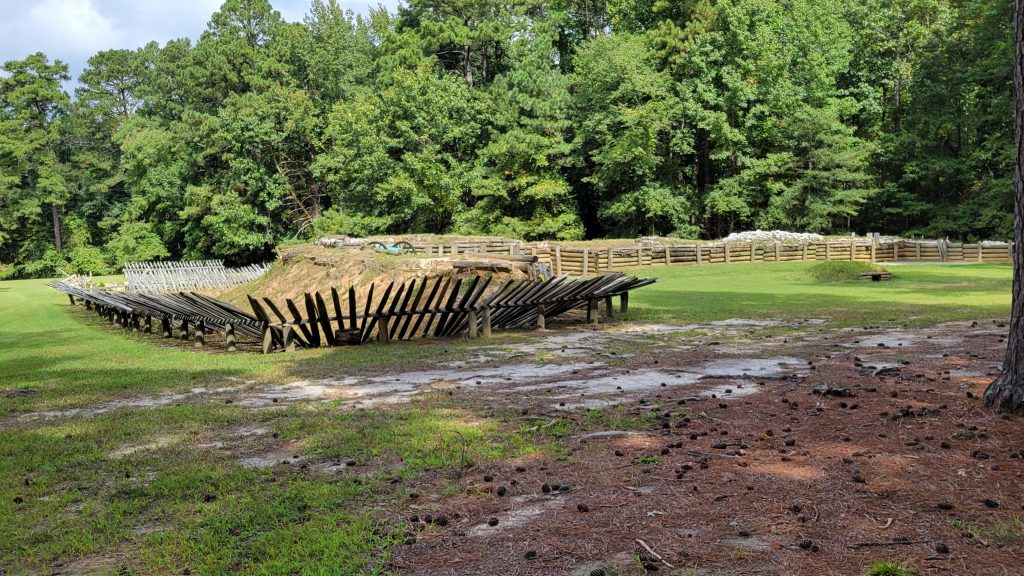September 13, 2024 @ 10:00 EST
Site Visit #161
Traditional American history teaches that the U.S. Civil War ended with General Lee’s surrender of the Army of Virginia at Appomatox Court House on April 9, 1865. At Petersburg National Battlefield, though, I learned that it was really over following the battle at Five Forks on April 1. “Skirmish” may be a better description when compared to the horrific major battles of this war. Why was this battle the end for the Confederacy?
For the first three years of the war, President Lincoln went through multiple generals to lead the Army of the Potomac – the Union army in the eastern theater tasked with capturing Richmond. All had been spectacular failures when going up against Confederate general Robert E. Lee. Finally, in April 1864, Lincoln summoned Ulysses Grant to take over the army in the east. Grant had been highly successful in the western theater, capturing Vicksburg and most of Tennessee.
There are two approaches an army might take in trying to advance toward, for example, Richmond. They can try to minimize casualties by backing away from engagements where they are being defeated and attacking again at a later date. Unfortunately, this tends to leave a stalemate as the attacking army never gains much if the opponent can make it too costly. This was the approach taken for three years by Union generals.
Grant took the other approach. When he appeared defeated in early battles against Lee, and troops expected to retreat to safety, he instead pushed on to the south forcing Lee to pursue. This led to higher casualties among his forces. Hence, the age-old question. Which saves more lives in the long run?
Under Grant’s leadership, the army reached the outskirts of Richmond by the end of May. However, he was stopped at the battle of Cold Harbor (which I will visit tomorrow) and further attempts to break the Confederate line at Richmond failed. Grant changed his target.

Petersburg, south of Richmond, was a major transporation center with roads and railroads converging on it. Food and supplies for Richmond came through here. If Grant captured Petersburg, Richmond would fall. However, Petersburg proved as difficult as Richmond to capture as Lee certainly knew of its importance. With frontal attacks failing, Grant turned to the strategy that worked at VIcksburg: he laid siege to the city.
The siege lasted over nine months, as Union troops slowly circled the city, cutting off one road and one railroad at a time. By the end of March, 1865, only one railroad line still reached the city – the South Side Railroad, which came into the city from the southwest. Just south of the rail line was Whote Oak Road, which met four other roads at an intersection called (surprisingly) Five Forks.
Grant sent a large force to capture the South Side Railroad near Five Forks. Lee sent General Pickett (best known for a charge at Gettysburg) to defend it “at all costs”. Her couldn’t do so as the Union forces were too much. The South Side rail line was cut and Petersburg could no longer be supplied, meaning Richmond could not either.
Lee took his troops west hoping to meet up with Johnston’s army in North Carolina, but I suspect he knew this war was over. When Grant’s troops blocked his way at Appomatox Court House just over a week later, Lee surrendered.
The Eastern Front Visitor Center for Petersburg National Battlefield offers a nice video on the siege, along with information on the driving tours for the Eastern and Western Fronts as well as the Five Forks Battlefield. Five Forks itself has a smaller Visitor Center with a video specifically about that battle. The actual park lands are spread out to cover many of the major clashes that happened around the city during the siege. A large area of park-owned land covers the Eastern Theater, whereas the other locations own less land, concentrating on specific events. The American Battlefield Trust has been instrumental in helping protect some of the lands for the Park Service.
Steve